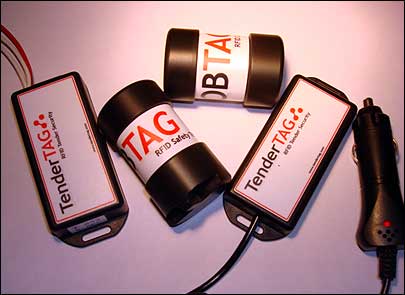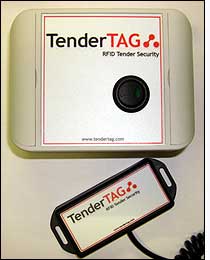As yacht owners scale up the size of their vessels, they’re also investing in bigger, fancier and more expensive tenders—the auxiliary boats used to access docks or transport individuals when the yacht itself is too large for the task. These tenders, which can reach values of $100,000 or more, can be too sizable to be stored on a yacht, so they must be towed behind it in open waters. This raises security problems, and the risk of losing the smaller craft somewhere at sea.
A British Columbian startup company known as Active Tag Security says it has come up with a solution—the TenderTag—that employs radio frequency identification to generate an alarm if a tender becomes separated from its parent vessel.

Phillip Richards, who serves as captain for his employer’s yacht from his base in the Caribbean, has been using the system for the past year to ensure he doesn’t lose track of his tender. Richards typically tows the smaller boat behind the 150-foot yacht between the Caribbean and New England, and to Belize. Although the tender has not broken free thus far, he says, the TenderTag system offers him assurance that he will be able to respond in sufficient time to recover the watercraft if ever it does so.
Typically, a tender is lost in rough conditions in which waves can cause the towline to break free. If the ship’s captain fails to notice the incident immediately, it can be almost impossible to locate and recover the auxiliary craft. In other cases, bandits sometimes steal high-value tenders before the captain realizes what is happening.
Richards is utilizing the TenderTag system to prevent both risks. He attached a TenderTag 2.4 GHz active RFID tag to the overhead arch on the tender. Measuring approximately 3 inches by 1.5 inches, the tag—which employs a proprietary air-interface protocol—comes with a power cord that plugs into the 12-volt cigarette lighter socket located on the smaller boat. Once installed, the tag transmits its unique ID number at a rate of about 10 times per second, says Glen Snaychuk, one of Active Tag Security’s owners.
Richards installed the reader on the back of yacht. The interrogator can receive transmissions from a distance of 400 feet, as long as there is a clear line of sight. The device is set to sound an alarm if it fails to receive the tag’s signal within a specified time period. Because waves can occasionally obstruct a reader’s line of sight with the tag, Richards has programmed his reader to emit an alert if it has not received a signal within the past 20 seconds.
“It’s loud—I can easily hear it in the wheelhouse,” Richards says, while the device itself is installed at the back of the yacht. “It’s a really good idea, and it works quite well.”
To date, Richards says he’s had no problems with the system, though he learned upon first attaching the tag to the tender that it has to be placed as high on the boat as possible, in order to maintain a line of sight in the open water. The waves and wind, he notes, have not caused any damage to the mechanics. “It’s pretty much bulletproof,” Snaychuk says. “The waves and the weather won’t affect it.”
The retail price for the system ranges from $475 to $575. Active Tag Security manufactures the hardware, as well as the software enabling the reader to be programmed to sound its audible alert after failing to detect a tag’s signal within a predetermined length of time.
Rick Bowers, a customer service representative for yacht logistics and provisioning firm National Marine Suppliers, based in Fort Lauderdale, Fla., says he sells the devices to ship owners as a form of security, to help them protect their property. “It’s a nice tool to have something that—for a few hundred dollars—can protect a tender worth tens of thousands of dollars,” he states.
For those making a solo voyage, or who are on the deck of a ship alone, the company offers a version it calls the MOBTag. An RFID tag is clipped to a person’s belt or lifejacket. If that individual falls overboard, the boat’s engine will stop the moment the craft’s RFID reader ceases to pick up the tag’s signal. For sailing vessels equipped with autopilot and power sails, the system can be set up to drop the sails and steer full rudder, port or starboard.
Another maritime application on which Active Tag Security is currently working is the YachtTag, which comes with a software system that allows a reader to be connected to a yacht’s Internet service via satellite. Tags could be issued to crew members and be attached to on-board assets, as well as to tenders. The Active Tag Security software would enable a display of data showing each crew member, asset and tender, as well as their locations, on a Web server that could be accessed remotely, via a password, by the yacht owner or other interested parties, to ensure that no asset, craft or individual is missing.
In addition, the company is marketing RFID solutions for the construction and automotive industry, as well as for the tracking of personal property. The FleetTag provides security for backhoes or other construction vehicles by enabling their ignition switch to activate only if an authorized operator arrives with an RFID card that transmits an authorized ID number to an RFID reader wired to the ignition. The RadiusTag allows construction vehicle operators to receive an alert if their RFID-tagged vehicles come within range of another tagged vehicle, or a pedestrian carrying an RFID card. And the Smart-Key system enables a vehicle to remain operational only when its driver’s RFID card is in the vicinity. In that way, for instance, if a carjacker were to take a vehicle, the ignition system would immediately shut off once that vehicle traveled out of range of the authorized driver’s RFID card.
Finally, the Big Brother system allows users to track the movements of their personal property from a remote location, enabling them to log onto a Web site to check the status of any RFID-tagged items. If an item is moved out of range of the RFID reader, its status is updated and an e-mail message can be sent, warning the owner.



